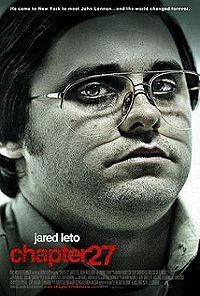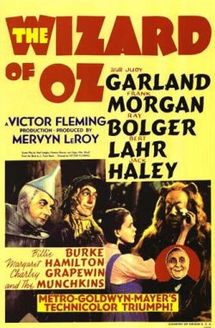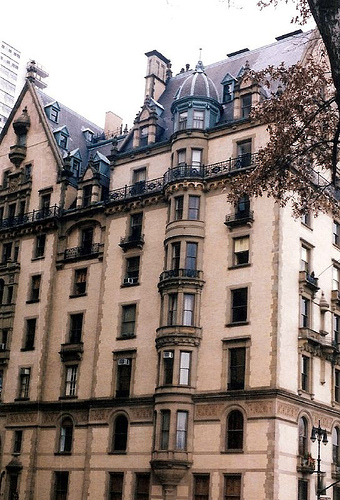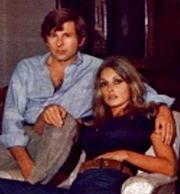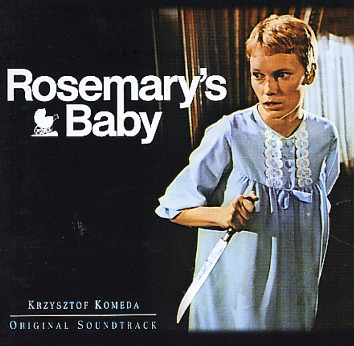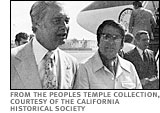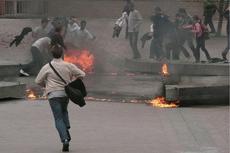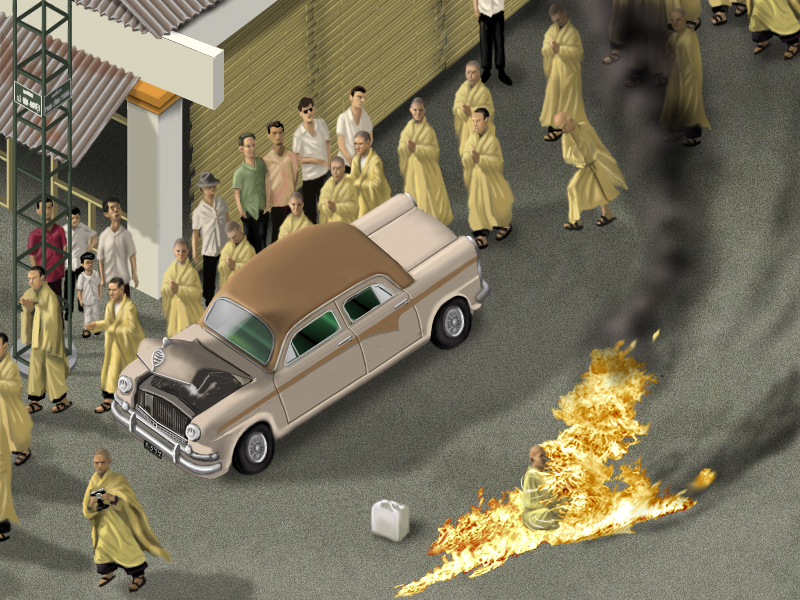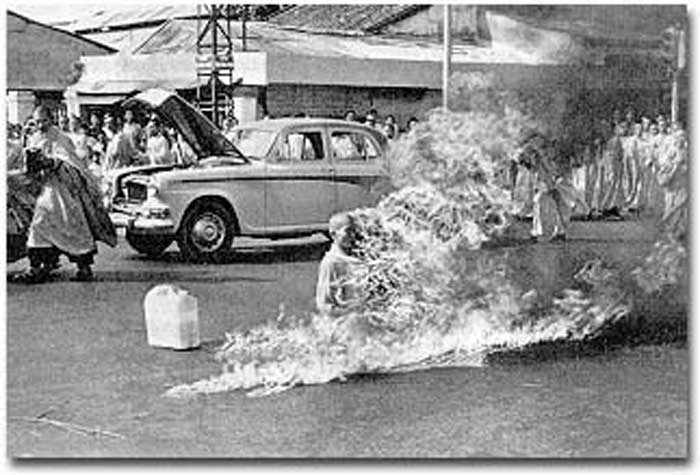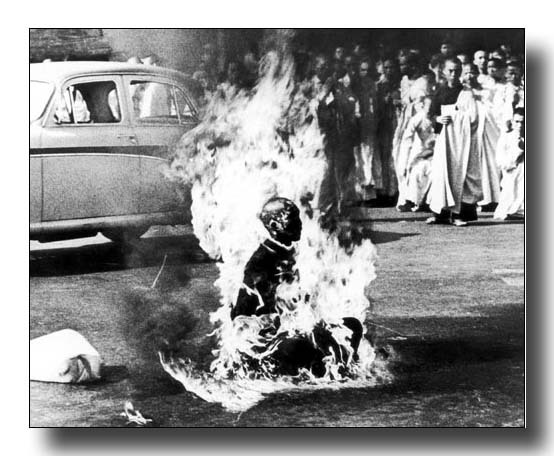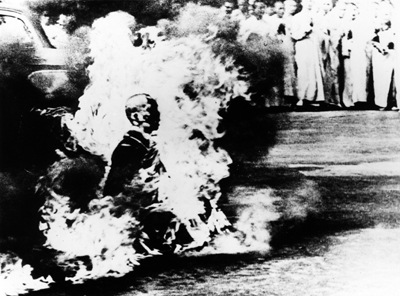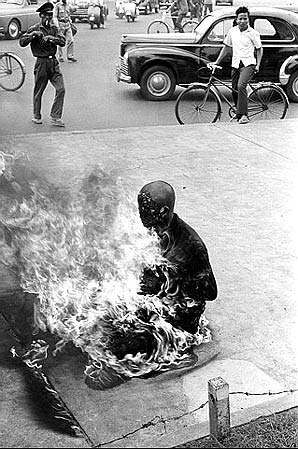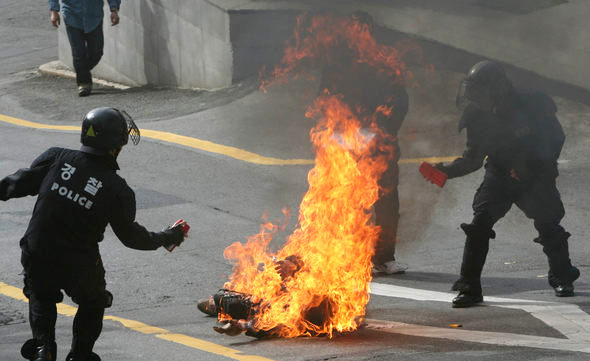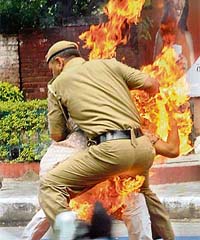Synchronicity is the coincidental occurrence of events that seem related but are not explained by conventional mechanisms of causality. As we look more closely at the attacks in Mumbai, India, how does one separate the human planning from the synchronicity that apparently underlies these events?
The events will reveal many "coincidences" as the attacks are charted and deconstructed.
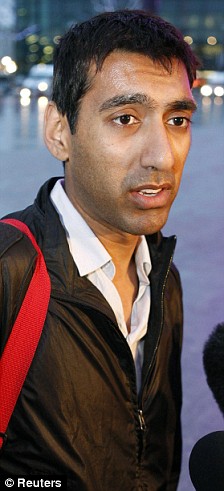
How does an actor who played a terrorist bomber find himself in the midst of a terrorist attack? Daily Mail photo, above.
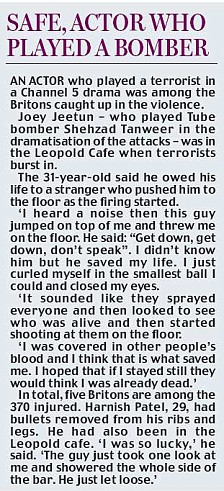
Where, who, why?
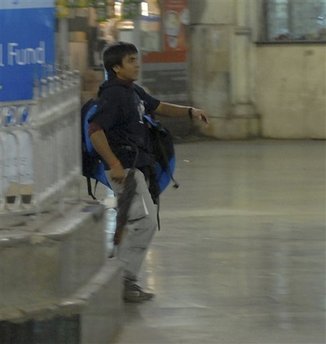
A gunman enters the Chatrapathi Sivaji Terminal railway station in Mumbai, India, Wednesday, November 26, 2008, opening AK-47 gunfire and throwing hand genades, killing at least ten people immediately, including three railway officials. Teams of gunmen in coordinated attacks, storm luxury hotels, a popular restaurant, hospitals and a crowded train station across India's financial capital, killing people, taking Westerners hostage and leaving parts of the city under siege for three days. (Mumbai Mirror, Sebastian D'souza)
Before even an attempt at "why," first let's get straight to the "where" of the attacks. What sites have been hit? Of ten reported, these are the known targets:
1) South Mumbai Police Headquarters;
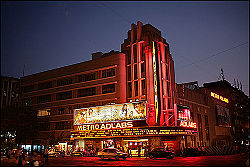
2) Metro Adlabs cinema (historic Art Deco movie theater; Mumbai is the center of the Bollywood film industry);
3) Chhatrapati Shivaji Terminus (railway station);
4) Cafe Leopold (a major tourist center in Mumbai's Colaba area);
5) Nariman House, site of the Chabad Lubavitch Centre (Jewish center);
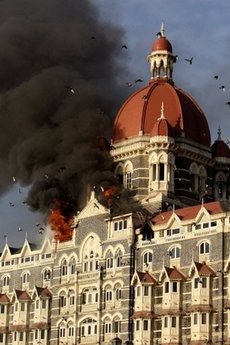
6) Taj Mahal Palace and Tower hotel (above, a castle-like 1903 landmark, across from the Gateway of India monument);
7) Oberoi-Trident Hotel (five star hotel used by foreigners, such as former guests Rupert Murdoch and Bill Gates);
8) Cama Hospital;
9) Vile Parle suburb, North Mumbai; and
10) Mazagaon docks.
It has also been reported that, "Low-intensity blasts were reported in Vile Parle and a grenade attack in Santa Cruz. Two blasts were reported in the Nepean Sea Road area of south Mumbai. Local Mumbai Suburban Railway trains on the Western Railway are running, whereas those of the Central Railway are suspended. More blasts were reported at the Oberoi as the siege continued. Meanwhile, police seized a boat filled with arms and explosives anchored at Mazgaon dock off Mumbai harbour."
I have privately been noting to associates that I think probably eleven sites were actually attacked, not ten. The twilight language use of "11" has been very significant in the history of such terrorist attacks, and sends a message to other founders. (Noted researcher Brad Steiger, "I will swear that the first announcement that I heard regarding the attacks stated that eleven locations had been hit." But even though his wife said she heard ten "10" all other mentions told of "10," Steiger still is certain he heard "11.")
The July 11, 2006 Mumbai train bombings were a series of seven bomb blasts that took place over a period of 11 minutes on the Suburban Railway in Mumbai, killing 209 people and injuring over 700. The reason the 2008 attacks are being called "India's 911" versus the 2006 attacks is due to the 2008 Mumbai's coordinated multi-attacks at several sites, the destruction occurring, the individuals killed, and, for the terrorists, the great media impact they were able to deliver. Media attention is very much a motivation for terrorists, and the wall-to-wall cable news coverage for over three days in the West was a goal, no doubt.
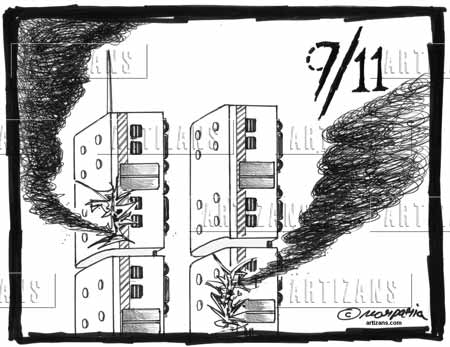
This is how artist Hemant Morparia remembered the earlier 7/11/2006 attacks on Mumbai. He entitled his work, "Mumbai's 9/11."
The site, The Daily Behemoth took a look at the name game apparent with "Mumbai.":
Its present name of Mumbai- used, formally, since 1996, and informally for many centuries before that by speakers of Gujarati- is combined from the local goddess Mumba, and a word meaning 'mother', 'Aai'.
According to Wikipedia, Mumba was the patron of the original inhabitants of the seven islands, the salt collectors and fisherfolk; and is still deeply venerated in the city's seventeenth-century Mumba Devi Temple.
Most intriguingly, Mumba is depicted inside the temple as a black stone sculpture: evoking obvious comparisons not only to the Black Madonnas of Templar-infused Catholicism and Isis, but to the origins of Islam in the pagan worship of the Kaaba at Mecca (a word related to Cybele.) Devi is a Sanskrit word, synonymous with Shakti, the female aspect of the divine.
Other insights can be gained by reading about the "Trident" name at Through the Looking Glass, where Todd Campbell points to the iconic "Indian trident or Trishula of the Goddess Shiva,"linked to the name of one of the major hotels attacked.
Also the astrology of the events is examined at Etemenanki. Indeed, Etemenanki has posted an elaborate astrological precusor chart (below) linking the time and space to the sites of India and Indiana, and a couple opposing temporal points on the calendar. (Bizarrely, on Friday, November 28, 2008, Indiana was in the news again, when five deer jumped off an interstate highway.)
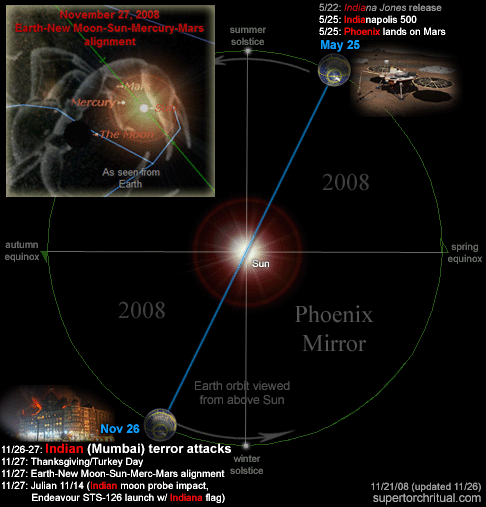
Who are the victims? (Piles of bodies were found Friday after commandos stormed the Taj Mahal Palace hotel, the last of three buildings that terrorists had occupied in the city. The death toll may be close to 300 killed, who were mostly Indians.)
Gunmen who burst into the Taj "were targeting foreigners. They kept shouting: `Who has U.S. or U.K. passports?'" said Ashok Patel, a British citizen who fled from the hotel.
Authorities believed many foreigners were prisoners at the Taj Mahal hotel.
Early reports on Wednesday night indicated at least three top Indian police officers — including the chief of the anti-terror squad — were among those killed. Indeed, most media accounts mention Hemant Karkare, the chief of the Mumbai police's anti-terror squad as one of the first people killed. These individuals were one of the first targets, apparently.
Officials at Bombay Hospital, speaking on condition of anonymity, said a Japanese man had died there and nine Europeans were admitted, three of them in critical condition with gunshot wounds. All were brought in from the Taj Mahal hotel, the officials said.
Brooke Satchwell, an Australian actress who starred in the television soap Neighbours, said she narrowly escaped the gunmen by hiding in a bathroom cupboard at the Taj, where she was staying for a film shoot.
Only a little news is slowly being released on the victims, with, of course, the Americans being noted by the American press.
Who are the known Americans killed in Mumbai?
Rabbi Gavriel Noach Holtzberg, 29, and his wife, Rivkah, 28, died in the attack on the ultra-Orthodox Chabad-Lubavitch movement's center in Mumbai, Rabbi Zalman Shmotkin said in New York. Their son, Moshe, was rescued by a brave staff member who had earlier been able to flee with the baby.
The group said three other victims in the building apparently had been visiting there. Shmotkin said the dead included Bentzion Chroman, an Israeli with dual U.S. citizenship; Rabbi Leibish Teitlebaum, an American from Brooklyn; and an Israeli woman whose name was not released. The Israeli Foreign Ministry said the body of a fourth victim, an unidentified woman, was also found inside the five-story building.
Some of the victims had been bound.
Two other American individuals have been identified as Alan Scherr, 58, and his daughter Naomi, 13, both there on a spiritual trip with a group called the Synchronicity Foundation. Alan Scherr was a Vedic astrologer.
According to the foundation's Web site, the community is led by Master Charles, a former leading disciple of Swami Paramahansa Muktananda. He is described on the Web site as "one of the most popular spiritual teachers from India to build a following [in] the West in the 1970s." He taught a form of yoga.
The Washington Post says this about the Scherrs:
Twelve years ago, Alan Scherr committed his life to meditation and spirituality, moving his family to the Synchronicity spiritual community in Faber, Va., about 30 miles southwest of Charlottesville in the Blue Ridge mountains.
It was that spiritual journey that led the former art professor at the University of Maryland to be in Mumbai Wednesday evening, eating a late dinner with his 13-year-old daughter at the Oberoi Hotel, when armed gunmen attacked. Both Alan and Naomi Scherr were killed. Local media had reported that they were killed at the historic Leopold Cafe, but U.S. officials later said that the two died at the Oberoi.
The Scherrs were among 25 participants from the Synchronicity community who had traveled to a program in Mumbai. Four other members of the group were injured in the shooting, the Associated Press reported.
According to a statement put out by Synchronicity this morning, Scherr, 58, and his wife, Kia, had been part of the community since the 1990s. Kia Scherr and the couple's other children had not traveled to India on the spiritual mission, the AP reported.
"Alan committed most of his adult life to meditation, spirituality and conscious living," the statement from Synchronicity said. "He was a passionate Vedic astrologer and meditation teacher who inspired many people to begin a journey of self-awareness and meditation. He was committed to making a positive difference in the world and devoted himself to the community he lived in."
The Synchronicity statement described Naomi as "a bright and lively young woman who loved spending time with people and living life to the fullest. She was passionate, if not a little mischievous, and will be fondly remembered by many of us for colorful hair styles and radiant energy."
In an essay in the Web magazine Realization in 2000, Alan Scherr described his journey from college professor and follower of Eastern meditation to a member and full-time staff member of the Synchronicity community, led by Master Charles, described as a contemporary mystic and master of meditation.
After listening to Master Charles speak in 1994, Scherr wrote, he and his wife decided to join the community, which promotes high-tech meditation and a holistic lifestyle. They moved to Faber in 1996.
"For me, real freedom means living life in each moment, as it unfolds, without concepts or conditions." Scherr wrote. "It is a life very few choose because it requires an orientation and re-prioritization of life that is, in many ways, antithetical to our modern Western culture. And yet, it is always available whenever one is truly focused upon self-mastery. The miracle of this life continues to unfold for me on daily basis."
Bobbie Garvey, a Synchronicity spokesperson, told the Associated Press that other members of the mission narrowly escaped the armed attack.
Garvey identified those from the group who were injured in the shooting as Helen Connolly of Toronto, who was grazed by a bullet; Rudrani Devi and Linda Ragsdale, both of Nashville, who both underwent surgery for bullet wounds; and Michael Rudder of Montreal, who remains in intensive care after being shot three times. Other members of the mission narrowly escaped the attack.
The Baltimore Sun also noted:
"I would call them bright stars," said Bobbie Garvey, a spokeswoman for the Synchronicity Foundation meditation group, of the Scherrs. "Extraordinary, bright, very positive -- examples to the world."
The Scherrs had lived at the foundation all of Naomi's life, Garvey said. Alan Scherr's wife, Kia, and her two sons did not travel with them to India.
One captured individual (pictured widely from the train station attack), Azam Amir Kasav, a 21 year old terrorist, has told authorities that the terrorists arrived at Mumbai from Karachi via Porbandar. He reportedly said that he and other terrorists had received automatic loading revolvers, AK-57, bullet magazines and dry fruits from their coordinator.
Azam confessed to the police that they wanted to replicate the attack that destroyed the packed Marriott Hotel in the city of Islamabad, Pakistan, on September 20, 2008, and reduce the Taj Hotel to rubbles, replicating the 9/11 attacks in India. Pakistan's Human Rights Minister Farooq H. Naek said after the Islamabad attack: "This is 9/11 of Pakistan."
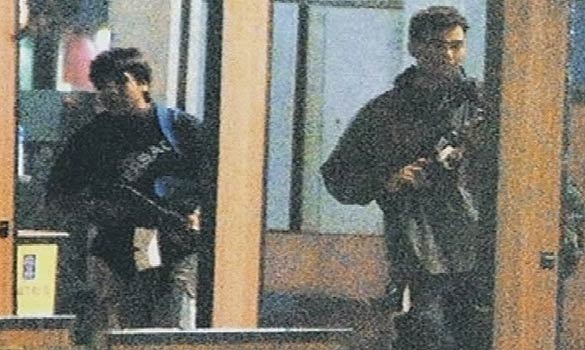
Azam melted in with the crowds, and reportedly wore an innocent looking "Versa" shirt, according to one reporter. Or did it say "Universal"? Probably it does refer to "Versace," as suggested by Todd, which is an Italian fashion label founded by Gianni Versace in 1978. Gianni Versace was killed by serial killer Andrew Cunanan on July 15, 1997.
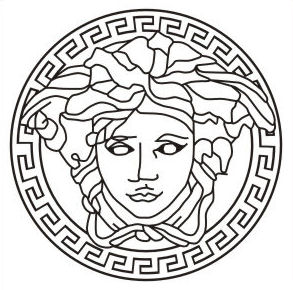
The Versace logo does appear to be the "innocent" icon visible on Azam's shirt.


The television coverage appeared unreal, at times. The violent movies of Hollywood seemed to be playing out in reality on the same streets that gives us Bollywood, where violence like it is not part of their scripts.
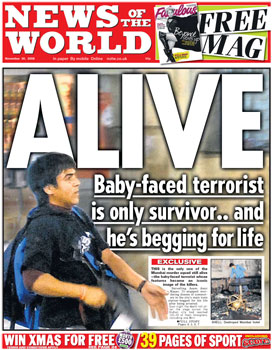
********
Update: Some of the well-known victims have begun to be identified.
Ashok Kapur, chairman of Yes Bank, was killed at Oberoi Hotel (attacked in dining area, but found dead on the 19th floor).
Bollywood actor Ashish Chowdhury's sister, Monica Chhabaria, and her husband were killed at the Oberoi. Chowdhury has appeared in numerous Indian films. According to the Indian media, he reportedly had a small role in the U.S. film Fight Club, starring Brad Pitt. But this is incorrect. Pitt's Fight Club was a 1999 film. Chowdhury's Fight Club: Members Only was a 2006 movie, according to the IMDBb
The body of Sabina Sehgal Saikia, a Times of India consulting editor and food critic, was recovered from the Taj hotel.
Boris Rego, a management trainee at the Taj Mahal hotel, was killed in the hotel's restaurant when gunmen barged in and opened fire.
The Taj hotel's general manager lost his family in a fire that broke out in the hotel Wednesday night. The bodies of Karambir Kang's wife and two children were burned beyond recognition in the fire, but it was unclear whether they were killed in the blaze.
A military funeral was held Saturday in Bangalore for Maj. Sandeep Unnikrishnan, a National Security Guard commando who was killed at the Taj hotel.
The body of another Security Guard officer, Gajendra Singh, was taken to New Delhi before being transported for last rights in his native Dehradun. He was killed at Mumbai's Chabad House, a Jewish community center where American-born rabbi Gavriel Noach Holtzberg and his Israeli wife, Rivka, were killed along with another American rabbi, Leibish Teitelbaum.
As mentioned before, Hemant Karkare, chief of Mumbai's Anti-Terrorism Squad, among 17 police killed.
IBN listed other slain police officers as:
Ashok Kamte (IPS), additional commissioner of police, East Region, Mumbai.
Vijay Salaskar, police inspector, anti-extortion cell, Mumbai.
Shashank Shinde, police inspector, CST Railway Police Station, Mumbai.
Praksh P. More, police sub inspector, LT Marg Police Station
Bapusaheb Durugade, police sub inspector, L.A.1, Naigaon
Tukaram G. Omble, assistant police sub inspector, D.B. Marg Police Station
Balasaheb Bhosale, assistant police sub inspector
Arun Chitte, police constable
Jaywant Patil, police constable
Yogesh Patil, police constable
Ambadas Pawar, police constable
M.C. Chowdhary, police head constable, R.P.F.
Mukesh B. Jadhav, Home Guard constable
Sources: Associated Press, IDN India News, CNN, MSNBC, Synchronicity Foundation, Mumbai Mirror, Times of India, Baltimore Sun, Washington Post, Yahoo News, Through The Looking Glass, and The Daily Behemoth.
